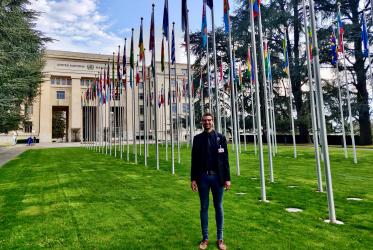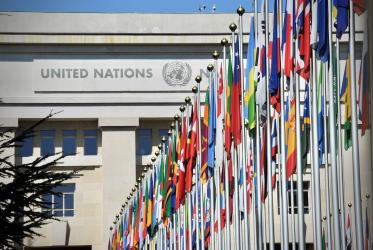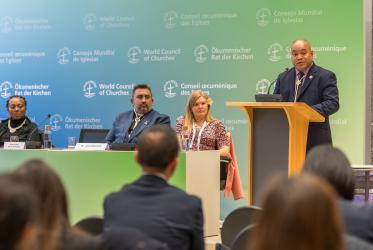By Binu Alex
French, German and Spanish versions of this feature will be available as of Monday 19 January
Young Christian delegates attending the World Social Forum (WSF) in the Indian commercial city of Mumbai unanimously agreed that the pressures leading to the growth of the sex trade are increasing with globalization.
A day ahead of the WSF opening, the World Council of Churches (WCC), together with the National Council of Churches, the Student Christian Movement and the Ecumenical Asian Students and Youth Network of India arranged a field exposure visit to Kamathipura, one of India's largest sex trade areas.
According to WCC youth secretary Freddy Knutsen, the purpose of the visit was to allow the visitors to "identify the real issues".
On the morning of 15 January, curious onlookers watched some fifty young people from across the world negotiating the congested streets of Kamathipura, whose principal lane teems with more than 100,000 sex workers.
"The poor become poorer, bad gets worse, and this is what globalization does to humans," explained Student Christian Movement of India general secretary Samuel Jaykumar.
In Kamathipura, the visitors were confronted with stark reality.
Nonchalant in their revealing clothes, the sex workers were a picture of life's struggles. Shock and distress was writ large on the faces of the visitors, most of whom were witnessing practitioners of this activity for the first time.
"It is really sad. I can't tell you how disturbing it is to see these women as mere commodities," said Andrea Fernandez from Brazil. She recollected that in her native country, the situation is no better.
Outside the dingy shanties of Kamathipura, the sex workers hardly have time for their ragged children as they aggressively woo customers.
Like all mothers, they dream of a better future for their merry-making, innocent kids. But as one of the sex workers admitted, most of the girls follow their mothers' footsteps, and the boys become pimps like their unknown fathers.
Kamathipura is named after the Kamathis, migrants from the southern Indian state of Andhra Pradesh. The first group came to Mumbai, then Bombay, in 1795 and gradually their settlement turned into the city's red-light district. Their fates were sealed by the end of the nineteenth century.
Every year, hundreds of helpless, destitute women from across the country, and even from neighbouring Nepal, land up in Kamathipura. Some of them are victims of the illegal sex trade and others have come due to economic pressures.
Mumbai, better known for churning out the world's highest number of movies and heavy stock trading, is the ultimate dream destination for every poor person looking for a decent living in India. But in most cases, the dream turns sour.
Brothels mushroom wherever there is high migrant population, although Kamathipura has the distinction of having already been a "comfort zone" back in the British era.
Today, the painted lips of teenage sex workers lure doubtful passers-by to rooms already crowded with customers.
"But there is hardly any income. AIDS has destroyed our business. We have to make ourselves available to doubtful customers for as low as 10 Rupees (US$22 cents)," said Minakshi junior.
While Minakshi junior, who looked in her 30s, is busy at the street corner, Minakshi senior, a few years older, has gone to her native town "somewhere in Nepal", to enrol her elder son in the tenth grade.
Names don't matter here. There are Minakshis and Mohinis and Rukminis, classified into juniors and seniors depending on their comparative ages. Some are simply "Badiwalis" (the elder ones) and "Chhotiwalis" (the younger ones).
Outside it's a chaotic scene. Cheap restaurants, illegal huts, street vendors and garbage strewn all over contribute to the permanent traffic congestion on the street.
Whatever little space available is occupied by streetwalkers soliciting business.
Roopa (not her real name) is just another soul peddling her body in the din.
"What do you think these people (the delegates) are here for?" Chatting with an elderly acquaintance, possibly her mentor, Roopa was aggressive: "Are they searching for a "pattaka" - a beauty?" The elderly woman, with Mongolian features, peeping out of a window above, gave a knowing smile.
Bright-coloured saris on the slanted and broken asbestos sheets made the otherwise dull surroundings look cheerful.
The pimps, constantly on the prowl, eyed the delegates with unease, not knowing where the interaction between the outsiders, some of them foreigners, with the women would lead.
"Are you part of a survey team?" a hesitant Harish Rao, who was reluctant to admit he was a pimp, wanted to know.
"Christians! Oh, they are good people but no use to us," said Rao in his heavily accented Marathi, the language of this region, not his mother tongue.
Rao is aware of development programmes for empowering women and children from Kamathipura. But his main concern is: "What about providing an alternative source of income to a community who has known only one source of income?"
Leena Vaidya, a social worker who has been working in the area for three years, said they have a definite plan of action to free the women and children. But it will take time to undo centuries-old practices.
Raj Bharath Patta, a theology student from Student Christian Movement of India, regretted that the number of sex workers has increased in a world of vaunted opportunities.
Shooting films or photography is strictly prohibited in Kamathipura.
"Why do you want to film us? We are here for your visual pleasure, and share our bodies," said Meenakshi, who refused to be documented on film, even with her face covered.
At the sight of an prospective customer, she withdrew to a corner and bowed her head in the direction of portraits of Hindu gods and goddesses, hanging on a wall facing the street.
The delegates returned to Robinson Memorial Marathi Methodist Church with the disturbing image of Meenakshi branded in their hearts. Conscious that growing poverty and desperation are contributing to the growth of the sex trade, they pledged to make another world possible.
Binu Alex is a Catholic Indian radio journalist based in Ahmedabad.
Information and photos on the activities of the World Council of Churches at the WSF in are available on our website:
www.wcc-coe.org/wcc/what/jpc/wsf-2004-e.html (in English)
www.wcc-coe.org/wcc/what/jpc/wsf-2004-f.html (en français)
www.wcc-coe.org/wcc/what/jpc/wsf-2004-g.html (auf Deutsch)
www.wcc-coe.org/wcc/what/jpc/wsf-2004-s.html (en español)
For further information, please contact:
In Mumbai: Binu Alex +91 982 401 3856
In Geneva: Juan Michel +41 22 791 6153, mobile +41 79 507 6363, [email protected]
**********
The World Council of Churches (WCC) is a fellowship of churches, now 342, in more than 100 countries in all continents from virtually all Christian traditions. The Roman Catholic Church is not a member church but works cooperatively with the WCC. The highest governing body is the assembly, which meets approximately every seven years. The WCC was formally inaugurated in 1948 in Amsterdam, The Netherlands. Its staff is headed by general secretary Samuel Kobia from the Methodist Church in Kenya.
World Council of Churches
Media Relations Office
Tel: (41 22) 791 6153 / 791 6421
Fax: (41 22) 798 1346
E-mail: [email protected]
Web: www.wcc-coe.org
PO Box 2100
1211 Geneva 2, Switzerland






